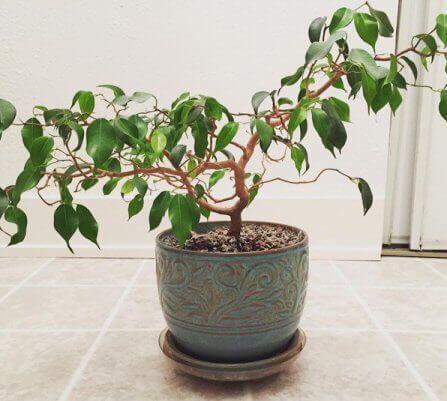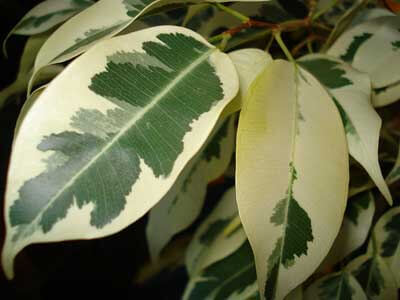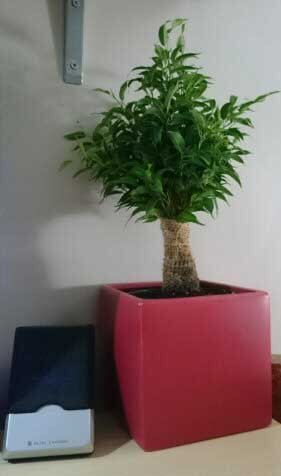





The Ficus Benjamina or as it's more commonly known, the Weeping Fig, is a common indoor houseplant which comes in multiple different looks and styles.  For example it can be grown as a tall bushy indoor plant, as a tall indoor tree with leafless braided trunks or even as a short pot plant. You may also come across this plant being grown happily as a Bonsai Tree.
For example it can be grown as a tall bushy indoor plant, as a tall indoor tree with leafless braided trunks or even as a short pot plant. You may also come across this plant being grown happily as a Bonsai Tree.
The leaves on the all green variety are unremarkable and the Weeping Fig is not a flowering houseplant, so its main attraction is the overall shape and elegant appearance that it creates. With reasonable care, you can have a tree-like indoor plant which is both grand and impressive but at the same time graceful and tranquil.
So is there anything that's not to like? Well as a house guest it can be a little messy. But for the majority of the time, this is an easy going, versatile houseplant that needs minimal attention and will reward you with something quite appealing to look at and compliment many settings from traditional to modern.  Weeping Figs tend to be reasonably priced and are frequently stocked anywhere that houseplants are sold. It's also an excellent plant to have around if you suffer from poor indoor air quality as it cleans and filters the air of harmful pollutants.
Weeping Figs tend to be reasonably priced and are frequently stocked anywhere that houseplants are sold. It's also an excellent plant to have around if you suffer from poor indoor air quality as it cleans and filters the air of harmful pollutants.
Aside from the height and physical appearance of this houseplant, the only other differing quality is the leaf colours. The all green variety, F. benjamina is perhaps the most common and easiest to grow, but there are several variegated varieties available if you prefer. The most beautiful of the variegated types is perhaps F. benjamina 'Starlight' - it has small patches of green on the leaves but large sections are cream coloured. Although its look is very unusual it's not for everyone and as a result you may need to search it out from specialist growers.
Light
Your Weeping Fig will need a location which is fairly bright in order for it to do well indoors. Some shade is okay, but you do have to be careful as if the light levels are too low then in a short time your plant will tell you it's unhappy by shedding leaves. Some direct sunshine will be fine, but only if it's sun from early morning or late afternoon.
Watering
Most Ficus plants are normally tolerant of occasional watering mistakes, so giving too much or too little from time to time will not usually do any long term harm.  Although for a thriving happy plant you want to get it right and that means keeping the soil moist for much of the time. In other words the potting soil should not be a soaking, sodden mess and equally, it shouldn't resemble bone dried dust.
Although for a thriving happy plant you want to get it right and that means keeping the soil moist for much of the time. In other words the potting soil should not be a soaking, sodden mess and equally, it shouldn't resemble bone dried dust.
Humidity
The humidity in your home or office isn't overly important to the Weeping Fig unless you aren't watering your plant correctly. Insufficient watering will mean the humidity needs to be higher and too much watering will mean low humidity levels are needed to decrease the chances of your plant rotting. Clearly the best option, therefore, is to ignore humidity as a care requirement completely and to be able to do that, you just need to water it correctly by following the instructions above.
Feeding
The leaves on your Weeping Fig might look small, but there is a lot of them which means it can be quite a heavy feeder. To keep your plant happy with lush green leaves look to feed up to once every month during the growing seasons, none in Winter.
Temperature
The average temperature in the average home or office is brilliant for this plant. If you're comfortable temperature wise, then so is your Weeping Fig. For active growth to occur the temperature needs to be at or above 15°C / 59°F. Always keep your Ficus out of cold draughts.
Repotting
Very young plants need to be repotted every year or so, as they can grow quite fast and will need space for their roots to grow into. Newly brought plants from a store which are a good size will most likely be mature enough to need less frequent repotting and so will only need this doing every two or three years.
Plants older than this will only need very occasion repotting, otherwise you risk heavy leaf fall. Very mature Weeping Fig's which are heavy to move, are best off not being repotted at all (unless you feel it's essential). Instead, they benefit more from scrapping off the top inch or two of soil and top dressing with fresh compost every couple of years.
Propagation
If the stems are quite young, supple and "new" opposed to older more woody ones, then you can propagate the Weeping Fig through stem cuttings. Cut a stem matching the above criteria, which is an inch or two long and then remove some of the leaves from this cutting if there are a lot. Two or three remaining leaves is ample to get the new plant going. Push the cutting a few centimeters into fresh potting soil and keep warm and the soil moist.
Use a rooting hormone to increase your chances and if possible keep the compost warm by providing bottom heat, which can be achieved by using a heated propagator. New leaf buds should start to form after a month or so, it may take longer in some instances but providing the stem is still "alive" the time it takes is not something to be concerned about. To create a "bushy" look, take several cuttings and grow them together as "one" plant.
Speed of Growth
 A Weeping Fig which has all its needs adequately met will grow moderately fast. This basically means it grows quick enough for you to notice it changing in shape and size, but not so quickly that it constantly outgrows the surrounding available space.
A Weeping Fig which has all its needs adequately met will grow moderately fast. This basically means it grows quick enough for you to notice it changing in shape and size, but not so quickly that it constantly outgrows the surrounding available space.
Height / Spread
The maximum height you can expect in an indoor Ficus Benjamina is 2m / 6ft. They do not reach this height quickly so if you've brought a small plant initially it will be many years before it reaches this tree-like potential. That could be good news if you bought a small plant and want to keep it that way. If on the other hand you want something tall quickly, buy a large Ficus to start with. Width wise, most Weeping Figs tend to be tall and slender rather than wide and spreading and so won't normally be wider than 0.5m / 50cm at the very most.
Flowers
The Weeping Fig is only grown indoors for its overall physical appearance and shape. Flowers are not at all common on indoor Ficus plants.
Anything else?
Unless you're truly exceptional at keeping houseplants (or just very lucky) there will come a time when you'll annoy your Weeping Fig and it will shed a huge number of leaves (see the problems section below for more details). This leaf fall can be quite messy and tiresome to pick up, so when choosing a spot for your plant make sure it's somewhere that you have easy access too and it's away from areas you don't want fallen leaves i.e. near food preparation areas.
Copyright © www.100flowers.win Botanic Garden All Rights Reserved